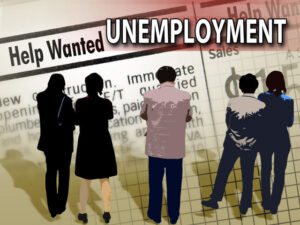
IT IS IMPOSSIBLE FOR UNEMPLOYMENT EVER TO BE ZERO
Source: Bob Marshall
‘Unemployment’ is an emotional ‘trigger’ word…a ‘third rail’, if you will. It conjures up negative thoughts. But it is important to realize that, while we want everyone who wants a job to have the opportunity to work, unemployment can never be zero and, in fact, can be disruptive to an economy if it gets too close to zero. Very low unemployment can actually hurt the economy by creating an upward pressure on wages which invariably leads to higher production costs and prices. This can lead to inflation. The lowest the unemployment rate has been in the US was 2.5%. That was in May and June 1953 when the economy overheated due to the Korean War. When this bubble burst, it kicked off the Recession of 1953. A healthy economy will always include some percentage of unemployment.
There are five main sources of unemployment:
1. Cyclical (or demand-deficient) unemployment – This type of unemployment fluctuates with the business cycle. It rises during a recession and falls during the subsequent recovery. Workers who are most affected by this type of unemployment are laid off during a recession when production volumes fall and companies use lay-offs as the easiest way to reduce costs. These workers are usually rehired, some months later, when the economy improves.
2. Frictional unemployment – This comes from the normal turnover in the labor force. This is where new workers are entering the workforce and older workers are retiring and leaving vacancies to be filled by the new workers or those re-entering the workforce. This category includes workers who are between jobs.
3. Structural unemployment – This happens when the skills possessed by the unemployed worker don’t match the requirements of the opening—whether those be in characteristics and skills or in location. This can come from new technology or foreign competition (e.g., foreign outsourcing). This type of unemployment usually lasts longer than frictional unemployment because retraining, and sometimes relocation, is involved. Occasionally jobs in this category can just disappear overseas.
4. Seasonal unemployment – This happens when the workforce is affected by the climate or time of year. Construction workers and agricultural workers aren’t needed as much during the winter season because of the inclement weather. On the other hand, retail workers experience an increase in hiring shortly before, and during, the holiday season, but can be laid off shortly thereafter.
5. Surplus unemployment – This is caused by minimum wage laws and unions. When wages are set at a higher level, unemployment can often result. Why? To keep within the same payroll budget, the company must let go of some workers to pay the remaining workers a higher salary.
Other factors influencing the unemployment rate:
1. Length of unemployment – Some studies indicate that an important factor influencing a workers decision to accept a new job is directly related to the length of the unemployment benefit they are receiving. Just recently the government re-extended the eligibility for unemployment benefits from 26 weeks to as much as 73 weeks. Studies suggest that this reduces the incentive of the unemployed to seek and accept less desirable jobs.
2. Changes in GDP – Since hiring workers takes time, the improvement in the unemployment rate usually lags behind the improvement in the GDP.
Source: Bob Marshall





